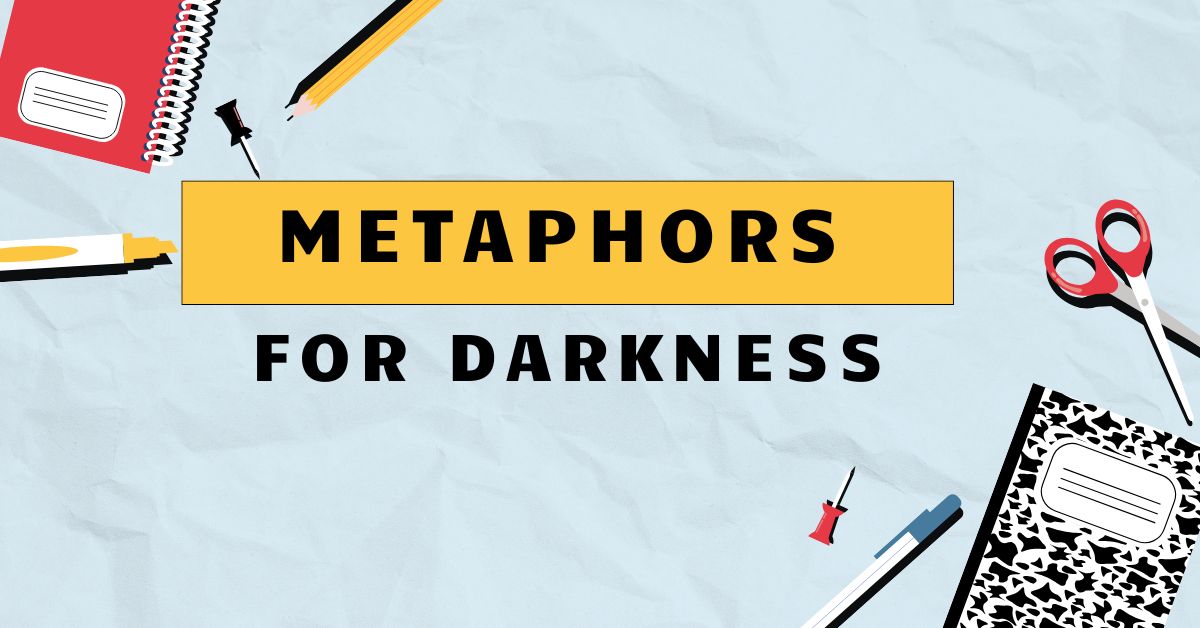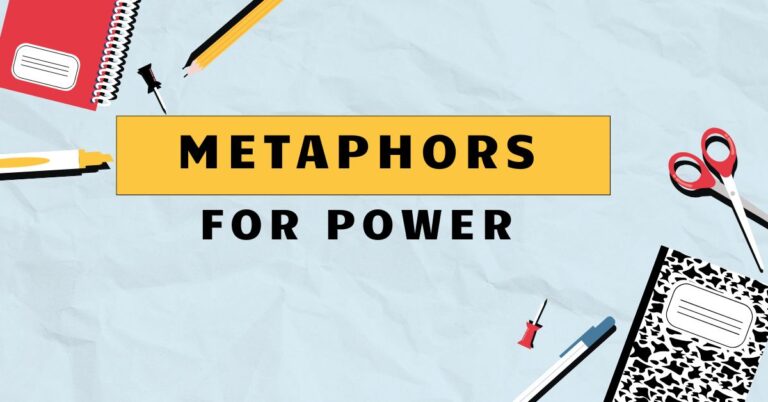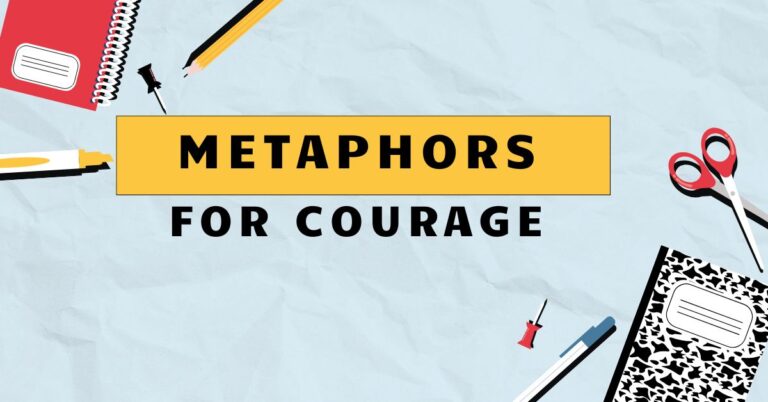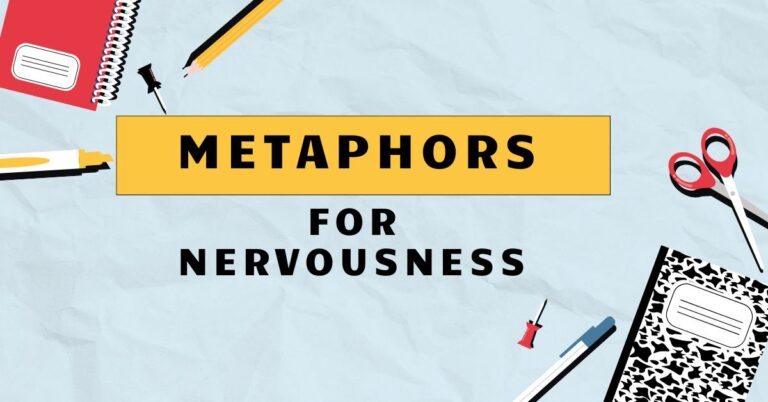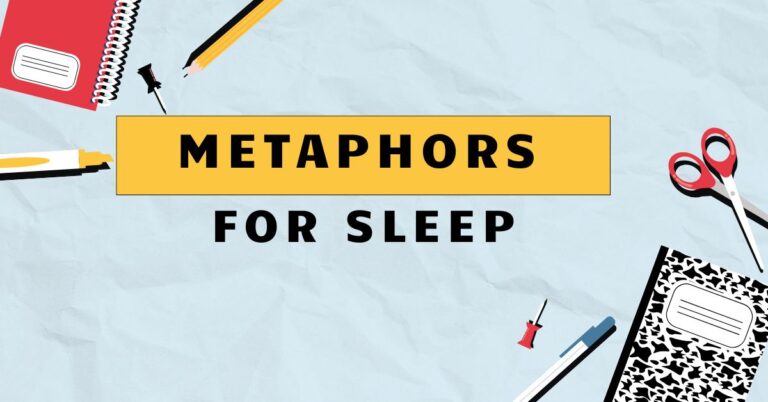38+ Metaphors for Darkness: A Comprehensive Guide
Metaphors are essential tools in language, allowing us to understand abstract concepts by relating them to more concrete experiences. When we talk about “darkness,” we often go beyond its literal meaning, using metaphors to evoke emotions, describe situations, or symbolize complex ideas.
Understanding metaphors for darkness enriches our comprehension of literature, poetry, and everyday language. This article is designed for English language learners of all levels, writers seeking to enhance their descriptive skills, and anyone interested in the nuances of metaphorical language.
Table of Contents
- Introduction
- Definition of Metaphor and Darkness
- Structural Breakdown of Darkness Metaphors
- Types and Categories of Metaphors for Darkness
- Examples of Metaphors for Darkness
- Usage Rules for Metaphors of Darkness
- Common Mistakes When Using Metaphors for Darkness
- Practice Exercises
- Advanced Topics in Darkness Metaphors
- Frequently Asked Questions
- Conclusion
Definition of Metaphor and Darkness
Ametaphoris a figure of speech that directly compares two unrelated things, asserting that one thingisanother. This comparison is not literal but figurative, designed to create a vivid image or understanding.
Metaphors differ from similes, which use “like” or “as” to make a comparison. For example, “He is a lion” is a metaphor, while “He is bravelikea lion” is a simile.
Darkness, in its literal sense, refers to the absence of light. However, metaphorically, darkness represents a wide range of abstract concepts, including ignorance, despair, evil, mystery, sadness, and the unknown.
The power of darkness as a metaphor lies in its ability to evoke strong emotional and psychological responses, making it a versatile tool for writers and speakers.
In essence, a metaphor for darkness takes the literal concept of the absence of light and applies it to describe or illuminate a different, often abstract, idea. This transfer of meaning allows for deeper and more impactful communication.
Structural Breakdown of Darkness Metaphors
Understanding the structure of metaphors for darkness involves analyzing how the literal concept of darkness is mapped onto the target concept. This mapping typically involves identifying common attributes or associations between the source (darkness) and the target (the abstract idea).
The structure can be broken down into the following components:
- Source Domain: This is the literal concept, in this case, darkness. It includes all the associated characteristics such as lack of light, obscurity, concealment, fear, and uncertainty.
- Target Domain: This is the abstract concept being described, like sadness, ignorance, or evil.
- Mapping: This is the connection between the source and target domains. It involves identifying the shared attributes. For instance, the obscurity of darkness can be mapped onto the lack of understanding associated with ignorance.
- Ground: The shared attributes or similarities between the source and target.
For example, in the metaphor “a dark secret,” the source domain is physical darkness (concealment), and the target domain is the secret (something hidden). The mapping occurs because darkness conceals physical objects, just as a secret conceals information.
The ground is concealment.
Another essential aspect is recognizing the cultural and contextual influences on the interpretation of darkness metaphors. The connotations of darkness can vary across cultures and historical periods, so understanding the specific context is crucial for accurate interpretation.
Types and Categories of Metaphors for Darkness
Metaphors for darkness can be categorized based on the abstract concept they are used to represent. Here are some key categories:
Emotional Darkness
This category uses darkness to describe negative emotions such as sadness, despair, grief, and fear. The obscurity and oppressiveness of darkness are mapped onto the feelings of being overwhelmed or lost in emotional turmoil.
Intellectual Darkness
Here, darkness represents ignorance, lack of understanding, or intellectual confusion. The absence of light symbolizes the absence of knowledge or clarity.
Moral Darkness
Darkness is used to depict evil, wickedness, corruption, or moral decay. The association of darkness with concealment and negativity makes it a potent metaphor for immoral behavior.
Existential Darkness
This category explores the darker aspects of human existence, such as mortality, meaninglessness, and the unknown fate after death. Darkness symbolizes the uncertainty and fear surrounding these profound questions.
Social Darkness
Darkness is used to describe societal problems like oppression, injustice, inequality, and corruption within social structures. The concealing nature of darkness can represent hidden agendas or systemic issues.
Examples of Metaphors for Darkness
The following sections provide detailed examples of metaphors for darkness, categorized by the type of abstract concept they represent. Each category includes a table with multiple examples to illustrate the variety and versatility of these metaphors.
Emotional Darkness Examples
These examples show how darkness is used to describe feelings of sadness, despair, and fear. The table below provides a comprehensive list.
| Metaphor | Explanation |
|---|---|
| A dark mood | Describes a state of sadness or depression. |
| The darkness of despair | Represents the overwhelming feeling of hopelessness. |
| A dark cloud hanging over her | Symbolizes a persistent feeling of sadness or worry. |
| His heart was shrouded in darkness | Illustrates deep sorrow or emotional pain. |
| She fell into a dark abyss of grief | Expresses profound and overwhelming sorrow. |
| A shadow of darkness crossed his face | Indicates a brief moment of sadness or concern. |
| The room was filled with the darkness of her sorrow | The sorrow is palpable and affects everything around her. |
| He was lost in the darkness of his thoughts | Suggests deep introspection and sadness. |
| Her smile couldn’t penetrate the darkness in her eyes | Conveys that her sadness overrides any attempt to appear happy. |
| A dark secret haunted his dreams | Implies a secret that causes emotional distress and nightmares. |
| The darkness of her past consumed her | Suggests that past traumas heavily influence her. |
| He was drowning in a sea of darkness | Expresses being overwhelmed by negative emotions. |
| A veil of darkness fell over the town after the tragedy | Indicates a collective mood of sadness and mourning. |
| The darkness crept into her soul | Suggests a gradual decline into despair. |
| His laughter could not dispel the darkness within him | Indicates that outward happiness cannot mask inner turmoil. |
| The darkness of loneliness enveloped him | Expresses a profound sense of isolation and sadness. |
| She battled the darkness of depression every day | Conveys a constant struggle against mental health issues. |
| His anger was a dark and stormy night | Compares anger to a turbulent and destructive force. |
| A dark feeling settled in her stomach | Suggests a sense of unease or foreboding. |
| The darkness of fear paralyzed him | Expresses how fear can immobilize someone. |
| He shielded himself from the darkness of the world | Indicates a desire to avoid negative or painful experiences. |
| The darkness of uncertainty loomed ahead | Suggests anxiety about the future. |
| Her tears were a river of darkness | Expresses the depth and intensity of her sadness. |
| He tried to escape the darkness of his memories | Indicates an attempt to forget painful past experiences. |
| The darkness in his eyes reflected a broken spirit | Conveys deep emotional damage. |
Intellectual Darkness Examples
These examples illustrate how darkness is used to represent ignorance, confusion, or lack of understanding. The table below provides a list of metaphors.
| Metaphor | Explanation |
|---|---|
| A dark age | Refers to a period of intellectual or cultural decline. |
| Lost in the darkness of ignorance | Expresses a state of lacking knowledge or understanding. |
| A dark secret | Represents hidden or unknown information. |
| The dark corners of the mind | Symbolizes unexplored or unconscious thoughts. |
| A dark mystery | Indicates something unknown and difficult to understand. |
| His mind was a dark and tangled forest | Suggests confusion and difficulty in understanding his thoughts. |
| The truth was hidden in the darkness | Implies that finding the truth requires effort and investigation. |
| He groped in the darkness for an answer | Expresses a struggle to find a solution or understanding. |
| A dark cloud of confusion surrounded the issue | Indicates that the issue is unclear and difficult to understand. |
| She shed light on the dark corners of the investigation | Implies clarifying or revealing hidden aspects of a situation. |
| The darkness of misinformation clouded their judgment | Suggests that false information led to poor decisions. |
| He was blinded by the darkness of his own beliefs | Indicates that his beliefs prevented him from seeing the truth. |
| A veil of darkness covered the historical facts | Implies that the truth about historical events is obscured. |
| The darkness of ambiguity made it hard to decide | Expresses difficulty in making a decision due to unclear information. |
| His explanation only deepened the darkness | Indicates that his explanation made the situation even more confusing. |
| The darkness of unanswered questions lingered in the air | Suggests that unresolved issues create a sense of unease. |
| He navigated through the darkness of complex data | Expresses the challenge of understanding complicated information. |
| A dark area of research remained unexplored | Indicates a field of study that has not been thoroughly investigated. |
| The darkness of the unknown stretched before them | Suggests uncertainty and apprehension about the future. |
| He was searching for a light in the darkness of his ignorance | Expresses a desire to gain knowledge and understanding. |
| The darkness of propaganda distorted the truth | Implies that propaganda obscures and twists the truth. |
| She illuminated the dark recesses of the problem | Indicates that she clarified or solved the most hidden parts of the problem. |
| A dark suspicion crossed his mind | Suggests a vague and unsettling feeling of doubt. |
| The darkness of the conspiracy concealed the truth | Implies that a conspiracy is hiding the real facts. |
| He stumbled through the darkness of his misunderstanding | Expresses difficulty in navigating a situation due to lack of clarity. |
Moral Darkness Examples
These examples demonstrate how darkness is used to represent evil, wickedness, or moral corruption. The table below contains several examples.
| Metaphor | Explanation |
|---|---|
| A dark soul | Represents a person who is evil or morally corrupt. |
| The darkness of his heart | Symbolizes inner evil or wickedness. |
| A dark deed | Refers to an evil or immoral act. |
| The dark side of humanity | Represents the evil or destructive aspects of human nature. |
| A dark secret | Indicates a secret that involves immoral or illegal activities. |
| The city was consumed by a darkness of crime | Suggests that crime is rampant and pervasive. |
| He descended into the darkness of corruption | Implies a gradual decline into immoral behavior. |
| The darkness of greed drove him to betray his friends | Indicates that greed led him to commit immoral actions. |
| Her actions were shrouded in darkness | Suggests that her actions were secretive and likely immoral. |
| The darkness of their plot was terrifying | Expresses the evil and disturbing nature of their plan. |
| He was a creature of darkness | Implies that he embodies evil or immoral characteristics. |
| The darkness of his past followed him | Suggests that past immoral actions continue to haunt him. |
| A dark shadow hung over the company’s ethics | Indicates that the company’s ethical standards are questionable. |
| The darkness of their intentions was clear | Expresses that their evil motives were evident. |
| He was lost in the darkness of his ambition | Suggests that his ambition led him to commit immoral acts. |
| The darkness of revenge consumed him | Indicates that his desire for revenge controlled his actions. |
| She fought against the darkness within herself | Expresses a struggle against her own immoral tendencies. |
| His words were tainted with a darkness of malice | Suggests that his words were filled with evil intent. |
| A dark stain on his reputation | Indicates that his reputation has been damaged by immoral actions. |
| The darkness of their regime oppressed the people | Expresses how their evil rule caused suffering. |
| He reveled in the darkness of his power | Implies that he enjoyed using his power for evil purposes. |
| The darkness of the conspiracy spread through the government | Suggests that the conspiracy corrupted the entire government. |
| A dark pact was made in secret | Indicates that an evil agreement was formed in secrecy. |
| The darkness of their lies concealed the truth | Implies that their lies hid the real facts and intentions. |
| He was a puppet of the darkness | Suggests that he was controlled by evil forces or people. |
Existential Darkness Examples
These examples explore the use of darkness to represent mortality, meaninglessness, and the unknown. The table below lists some of these metaphors.
| Metaphor | Explanation |
|---|---|
| The long dark night of the soul | Represents a period of spiritual or existential crisis. |
| The darkness of death | Symbolizes the unknown and feared aspects of mortality. |
| A journey into the darkness | Refers to exploring the unknown or facing difficult existential questions. |
| The darkness of the abyss | Represents the feeling of meaninglessness or emptiness. |
| Staring into the darkness | Indicates contemplating mortality or the unknown. |
| He faced the darkness of his own mortality | Suggests confronting the reality of his own death. |
| The darkness of the universe stretched endlessly | Implies the vast and incomprehensible nature of existence. |
| She sought meaning in the darkness of existence | Expresses a search for purpose in a seemingly meaningless world. |
| The darkness of uncertainty loomed before them | Indicates anxiety about the future and the unknown. |
| He wrestled with the darkness of his own insignificance | Suggests a struggle with feelings of being unimportant. |
| The darkness of the void beckoned him | Implies a sense of being drawn to emptiness or nothingness. |
| She found solace in the darkness of solitude | Indicates that she found comfort in being alone with her thoughts. |
| The darkness of the unknown was both terrifying and alluring | Expresses a mix of fear and fascination with the mysteries of life. |
| He questioned the light in the face of so much darkness | Suggests doubting the existence of good in a world filled with suffering. |
| The darkness of despair threatened to consume him | Indicates that hopelessness could overwhelm him. |
| She wandered through the darkness of her existential crisis | Expresses navigating a period of deep questioning and uncertainty. |
| The darkness of the grave awaited him | Implies the inevitability of death. |
| He sought answers in the darkness | Suggests looking for meaning in the face of life’s mysteries. |
| The darkness of the human condition | Represents the inherent suffering and challenges of being human. |
| She embraced the darkness of the moment | Indicates accepting the difficult or uncertain aspects of life. |
Social Darkness Examples
These examples illustrate how darkness can represent social issues such as oppression, injustice, and inequality. The table below contains some of these metaphors.
| Metaphor | Explanation |
|---|---|
| A dark period in history | Refers to a time of oppression, injustice, or conflict. |
| The darkness of poverty | Represents the suffering and hopelessness associated with poverty. |
| A society shrouded in darkness | Indicates a society characterized by corruption or oppression. |
| The dark corners of the city | Symbolizes areas plagued by crime, poverty, or neglect. |
| A dark age of inequality | Refers to a time when inequality is rampant and severe. |
| The darkness of oppression silenced the people | Suggests that oppression suppressed the voices of the population. |
| He shone a light on the darkness of corruption | Implies exposing corrupt practices within the system. |
| The darkness of injustice prevailed | Indicates that unfair treatment was widespread. |
| A dark shadow of discrimination loomed over the community | Suggests that discrimination negatively affected the community. |
| The darkness of their policies harmed the vulnerable | Expresses that their policies caused suffering to those in need. |
| The darkness of the underworld thrived in the city | Implies that illegal activities prospered. |
| She fought against the darkness of systemic racism | Indicates a struggle against deeply ingrained racial biases. |
| The darkness of exploitation plagued the workforce | Suggests that workers were subjected to unfair treatment. |
| A dark cloud of censorship hung over the media | Implies that freedom of expression was suppressed. |
| The darkness of political manipulation was widespread | Indicates that political processes were being dishonestly controlled. |
| He navigated through the darkness of bureaucratic red tape | Expresses the difficulty of dealing with complex administrative processes. |
| The darkness of the prison system was appalling | Suggests that the prison system was characterized by inhumane conditions. |
| She exposed the darkness of human trafficking | Implies revealing the evil practices of human trafficking. |
| A dark chapter in the nation’s history | Refers to a time of significant social or political turmoil. |
| The darkness of social injustice persisted | Indicates that unfair treatment continued despite efforts to change it. |
Usage Rules for Metaphors of Darkness
When using metaphors for darkness, it’s important to follow certain guidelines to ensure clarity and impact:
- Context is Key: Ensure that the context makes the intended meaning clear. Avoid using metaphors that could be misinterpreted.
- Consistency: Maintain consistency in the metaphorical language used. Mixing metaphors can weaken the overall effect.
- Originality: Strive for originality in your metaphors. Overused metaphors can sound cliché and lack impact.
- Audience Awareness: Consider your audience and their understanding of the metaphorical language. Avoid using metaphors that may be unfamiliar or culturally inappropriate.
- Avoid Mixed Metaphors: Do not combine metaphors that create illogical or confusing images. For example, “He nipped that idea in the bud and ran with it” is a mixed metaphor.
Clarityis paramount. The goal is to enhance understanding, not obscure it.
If a metaphor is too convoluted or abstract, it will fail to resonate with the audience. Aim for metaphors that are both creative and accessible.
Common Mistakes When Using Metaphors for Darkness
Several common mistakes can weaken the effectiveness of metaphors for darkness:
| Mistake | Correct Example | Incorrect Example |
|---|---|---|
| Cliché Metaphors: Using overused expressions. | The city was a labyrinth of despair. | The city was a dark and stormy night. |
| Mixed Metaphors: Combining incongruous images. | His words cast a long shadow on the issue. | His words cast a long shadow on the issue, which was a slippery slope. |
| Lack of Clarity: Using metaphors that are too abstract. | Her grief was a deep, dark well. | Her grief was a chromatic dissonance. |
| Inconsistency: Shifting between different metaphorical frameworks. | The project was a dark tunnel leading to success. | The project was a dark tunnel leading to success, but it also needed to be pruned like a garden. |
| Misunderstanding Cultural Context: Using metaphors that don’t resonate with the target audience. | His future looked bleak and uncertain. | His future was a long night without a bonfire (if the audience is unfamiliar with bonfires). |
Avoiding these common pitfalls will significantly improve the quality and impact of your metaphorical language. Always strive for clarity, originality, and consistency in your use of metaphors.
Practice Exercises
Test your understanding of metaphors for darkness with these exercises.
-
Identify the metaphor in the following sentence: “The darkness of their lies concealed the truth.”
Answer: The darkness of their lies
-
What type of darkness metaphor is used in the sentence: “He was lost in the darkness of his thoughts.”
Answer: Emotional Darkness
-
Rewrite the following cliché metaphor using a more original expression: “A dark and stormy night.”
Answer: A night veiled in ominous shadows.
-
Correct the mixed metaphor: “The project was a dark tunnel but we need to nip it in the bud.”
Answer: The project was a dark tunnel leading to success.
-
Identify the metaphor in the following sentence: “The darkness of poverty consumed the city.”
Answer: The darkness of poverty
-
What type of darkness metaphor is used in the sentence: “He was blinded by the darkness of his own beliefs.”
Answer: Intellectual Darkness
-
Rewrite the following cliché metaphor using a more original expression: “A dark secret.”
Answer: A secret cloaked in shadows.
-
Correct the mixed metaphor: “Her words were a dark cloud and a slippery slope.”
Answer: Her words were a dark cloud hanging over the discussion.
-
Identify the metaphor in the following sentence: “The long dark night of the soul.”
Answer: The long dark night of the soul
-
What type of darkness metaphor is used in the sentence: “She fought against the darkness within herself.”
Answer: Moral Darkness
Exercise 1: Identify the Type of Metaphor
Identify the type of darkness metaphor (Emotional, Intellectual, Moral, Existential, or Social) used in each sentence.
| Sentence | Type of Metaphor |
|---|---|
| The darkness of poverty consumed the city. | Social |
| He was lost in the darkness of his thoughts. | Emotional |
| She struggled to understand the dark corners of quantum physics. | Intellectual |
| The darkness of his soul was evident in his cruel actions. | Moral |
| They contemplated the darkness of the abyss. | Existential |
| The darkness of oppression silenced the people. | Social |
| His heart was filled with the darkness of despair. | Emotional |
| She was blinded by the darkness of her own ignorance. | Intellectual |
| The darkness of his ambition led him to betray his friends. | Moral |
| He faced the darkness of his own mortality. | Existential |
Exercise 2: Fill in the Blanks
Fill in the blanks with an appropriate metaphor for darkness.
| Sentence | Answer |
|---|---|
| The truth was hidden behind a _______ of lies. | veil |
| He was trapped in a _______ of despair. | cycle |
| The city was a _______ of crime and corruption. | den |
| She felt a _______ of sadness wash over her. | wave |
| The project was a _______ leading to success. | tunnel |
| His past was a _______ that haunted him. | shadow |
| The country entered a _______ after the revolution. | era |
| Her future was a _______ with many paths. | forest |
| The job was a _______ of frustration. | maze |
| The trial was a _______ for the falsely accused. | nightmare |
Exercise 3: Create Your Own Metaphors
Create your own metaphors for darkness based on the given prompts.
| Prompt | Example Answer |
|---|---|
| Describe a feeling of deep sadness. | Her sorrow was a bottomless pit, swallowing all light and hope. |
| Describe a state of ignorance. | His mind was a locked room, the key lost in the shadows of misinformation. |
| Describe an act of moral corruption. | The deal was a pact with the devil, sealed in the darkness of greed. |
| Describe the fear of death. | Death was a silent ocean, its dark waves threatening to engulf him. |
| Describe social injustice. | Injustice was a heavy cloak, smothering the voices of the oppressed. |
| Describe a feeling of deep loneliness. | Loneliness was a vast, empty cavern, echoing with silence and despair. |
| Describe a situation where the truth is hidden. | The truth was a buried treasure, hidden beneath layers of deceit and lies. |
| Describe a time of war and conflict. | War was a raging inferno, consuming everything in its path with darkness and destruction. |
| Describe a person with evil intentions. | He was a serpent in the grass, his heart filled with venomous darkness. |
| Describe a place of poverty and despair. | The slums were a forgotten corner of the world, where hope withered in the darkness of neglect. |
Advanced Topics in Darkness Metaphors
For advanced learners, exploring the nuances of darkness metaphors can involve analyzing their use in literature, poetry, and philosophical texts. Consider the following:
- Symbolism: Investigate the deeper symbolic meanings associated with darkness in different cultural and literary contexts.
- Archetypes: Examine how darkness metaphors relate to Jungian archetypes such as the Shadow.
- Intertextuality: Analyze how different texts build upon and reinterpret existing darkness metaphors.
Furthermore, consider the use ofcontrast. Darkness is often juxtaposed with light to create a more powerful effect.
Analyzing how authors use this contrast can provide deeper insights into their themes and messages.
Explore how darkness metaphors evolve over time and across different genres. For instance, the use of darkness in gothic literature differs significantly from its use in contemporary psychological thrillers.
Frequently Asked Questions
-
What is the difference between a metaphor and a simile?
A metaphor directly equates two unlike things (e.g., “He is a lion”), while a simile uses “like” or “as” to make a comparison (e.g., “He is brave like a lion”).
-
Why is darkness such a common metaphor?
Darkness is a universal experience associated with a range of negative emotions and abstract concepts, making it a versatile and potent metaphor.
-
How can I avoid using cliché metaphors?
Strive for originality by thinking about the specific qualities of darkness and how they relate to the concept you are describing. Use vivid and unexpected language.
-
What is a mixed metaphor, and how can I avoid it?
A mixed metaphor combines incongruous images, creating a confusing effect. To avoid it, ensure that all parts of your metaphor are logically consistent.
-
How does cultural context affect the interpretation of darkness metaphors?
The connotations of darkness can vary across cultures,
and historical periods, so understanding the specific context is crucial for accurate interpretation. Some cultures may associate darkness more strongly with evil or mourning than others.
-
Can metaphors for darkness be positive?
Yes, although less common, darkness can sometimes represent positive concepts such as mystery, potential, or a necessary period of rest and introspection. For example, “the fertile darkness of the earth” suggests potential for growth.
-
How can I improve my skill in using metaphors for darkness?
Practice regularly, read widely to observe how skilled writers use metaphors, and seek feedback on your own writing.
-
What are some common symbols associated with darkness?
Common symbols include shadows, night, caves, and eclipses. These symbols can enhance the metaphorical power of your writing.
-
How do metaphors for darkness differ in poetry versus prose?
In poetry, metaphors for darkness tend to be more evocative and symbolic, focusing on emotional and aesthetic impact. In prose, they may be used more descriptively to enhance the reader’s understanding of a situation or character.
-
What role does contrast play in the use of darkness metaphors?
Contrast, especially with light, can heighten the impact of darkness metaphors. By juxtaposing darkness with light, writers emphasize the qualities and effects of both, creating a more nuanced and powerful image.
Conclusion
Metaphors for darkness are powerful tools for expressing complex ideas and emotions. By understanding the structure, types, and usage rules of these metaphors, you can enhance your communication skills and deepen your appreciation for language.
Whether you are a student, a writer, or simply someone interested in the nuances of English, mastering metaphors for darkness will enrich your understanding and expression.

